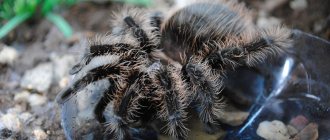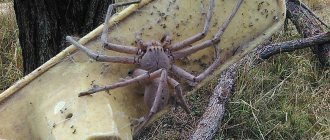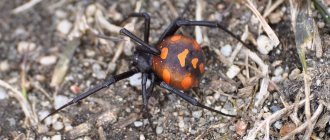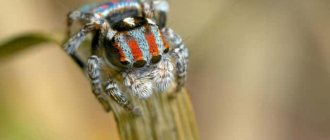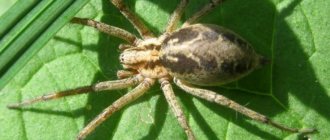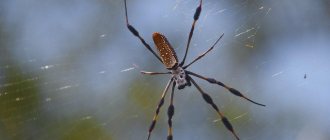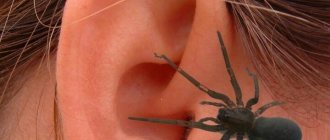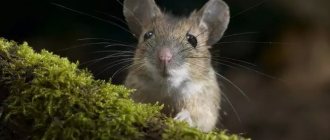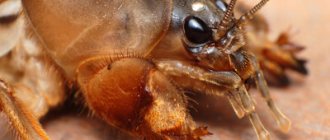On planet Earth, a large number, simply huge, of different amazing creatures live next to each other. Living organisms on earth live in water, on land, fly through the air, live and crawl underground.
Many people are afraid of spiders; they believe that they are mysterious representatives of the animal kingdom. Many people think that this is an insect, because in appearance it is very similar to them. However, let's figure out if this is really the case and who they really are.
Scientists say the first spiders appeared about 390 million years ago. Spiders supposedly originated from a crab-like creature. Science today numbers more than 41,000 species of spiders.
Comparison
Today there are about 42 thousand species of spiders on Earth. They are distributed everywhere. Apart from the jumping spider, all other animals of this order feed on other animals - insects, other spiders or small animals.
Insects are ubiquitous. To date, more than a million species have already been discovered, described and studied.
The spider's body consists of two sections - the cephalothorax and abdomen. Both parts are connected by a thin, short stem. On the cephalothorax there is a groove separating the head and chest parts. It is from the spider’s cephalothorax that the chelicerae “grow”—the spider’s two- or three-membered oral appendages with ducts of poisonous glands—and the entire “magnificent eight” of seven-membered legs. In the cephalothorax there are nerve nodes that form the central nervous system, brain and sensory organs, represented by simple eyes. Sensory hairs that detect odors and sound waves are located on the segments of the legs.
The body of insects consists of three sections - head, thorax and abdomen. On the head they have complex-faceted or simple eyes, antennae and mouthparts - sucking, gnawing, licking or piercing. The six segmented legs of insects are attached to the thoracic region of the body. In some subclasses of insects, a pair of wings also “grows” from the chest.
In the abdomen of the spider there is a heart that drives hemolymph, “book lungs”, a digestive gland, Malpighian glands, gonads and a spinning apparatus. Thanks to the glands located in it, the spider produces a web. Half of its chemical composition is the protein fibrin.
In the abdomen of the insect there are Malpighian vessels, genital organs with a diverse set of copulatory apparatus, which in some orders sometimes plays the role of a sting.
External structure of an insect using the example of a bee
Spiders catch their food using a web and inject poison (digestive juice) into it. After waiting several hours for the poison to dissolve the internal contents of the victim, the spider sucks out this nutrient solution using a sucking-type mouth opening located at the top of the tubercle between the chelicerae.
Insects are omnivores, they eat plants, animals, devour corpses, and are characterized by cannibalism.
Female spiders are in most cases larger and more colorful than males. Often, after mating, spiders eat their males. The color of all types of spiders uses only two color pigments - bilin and guanine.
In insects, sexual dimorphism and sexual polymorphism are noted - two types of females in bees, three types of males in stag beetles. The life cycle of insects is characterized by metamorphism, in which the animal goes through the stages of larva, pupa and adult. Insects can jump, fly, swim, live underwater, and glow in the dark. They are able to communicate using sounds and have the ability to excellently navigate in space.
Basic Concepts
Biologists classify living organisms according to the characteristics that unite them. Animals are creatures that move from place to place on their own and do not produce their own food from raw materials in their habitat. Those that cannot move of their own free will, but have the ability to move by the forces of nature or other means, synthesize food from the environment, are considered plants.
Within the numerous animal kingdom, there are organisms that lack a backbone - invertebrates. Representatives of this group are mostly small in size. Some of them are land dwellers, while for others the water becomes their home. They are all very different - they crawl, wriggle, walk and even fly. Since everything in science must be structured, scientists classified insects and spiders as a separate type - arthropods, or arthropods .
The main difference from insects is the more complex structure of the internal organs
Among the vast number of invertebrates, more than a million different species have bodies with three main parts - the head, thorax and abdomen. On the head there are eyes, antennae and mouthparts. The thoracic region has three pairs of legs. The entire body is protected by a hard outer covering called an exoskeleton. Organisms that have these characteristics belong to the class of insects.
Another, smaller group has only two main body parts - a combined head and chest (cephalothorax) and abdomen. The cephalothorax contains eyes, mouth parts (without antennas) and four pairs of legs.
Animals that fit this description are grouped into the class Arachnidae. This includes the spider, as well as the scorpion and the tick.
In this video you will learn about the structural features of spiders:dodo
Read on topic:
Where are funnel-web spiders found and are they dangerous?
14.11.2020
Why signs of arachnophobia appear and what to do about it
14.11.2020
The most popular types of Australian spiders
14.11.2020
The main types of spiders living in a house or apartment
05.02.2020
Conclusions TheDifference.ru
- The number of insect species exceeds the number of spider species.
- Spiders have 8 legs, insects have 6.
- The body of spiders consists of two sections, while that of insects has three.
- Only spiders are capable of producing webs.
- Spiders produce venom that is intended for external digestion.
- The life cycle of insects involves transformations - metamorphism; spiders do not have this phenomenon.
- The nervous system, behavior and communication of insects are much more complex than those of spiders.
Features of arachnids
Obviously, not all arachnids are the same. Biologists have found differences among representatives of this type of arthropod. Several main signs that spiders are not insects and also differ from other arachnids:
- the cephalothorax has no antenna, there are only 4 pairs of simple eyes, a pair of jaws and 2 pedipalps;
- basically have no wings;
- 4 pairs of articulated legs are attached to the cephalothorax;
- the abdomen is not segmented and is connected to the cephalothorax by a thin “waist”;
- the body is covered with an exoskeleton, and sensory hairs grow from the skin.
Interestingly, spiders have claws located at the end of each limb . The spider leg consists of seven segments: cox, trochanter, femur, patella, tibia and finally the tarsus, which may end in two or three small claws. Such features are necessary in order to help the animal cling to its web.
All 4 pairs of legs have muscles that attach to the inner wall of the cephalothorax and intestines. Surprisingly, it is precisely this internal structure that helps the spider suck out food. The circulatory system of these arthropods consists of a heart, arteries and veins, but does not have capillaries. The heart muscle has one cavity and, with the help of valves, moves blood in one direction. By the way, the color of spider blood is blue; it received such an unusual coloring due to hemocyanin dissolved in the lymph.
Spiders (like insects and animals) have a respiratory system, represented in these creatures by the trachea and lungs. The structure of lung tissue, of course, is very different from the human respiratory organs. All arachnid families do not have a muscular respiratory mechanism.
What do spiders eat and how do they reproduce?
Spiders are predatory animals and good hunters. When hunting, they can use a variety of methods, from passively sitting near traps built from webs, to actively searching and tracking their prey.
Male spiders have a complex courtship ritual, but it consists mainly of trying to avoid being captured by a female spider, which is much larger in size, and using the pedipalps to introduce their sperm into the female’s reproductive tract. And the most important thing is to try to survive in this process by avoiding the bite of the female; unfortunately, few people succeed in this.
Little baby spider Brachypelma Smitty
As a result of fertilization, the female lays up to 3000 eggs. In some species of spiders, the females die immediately after laying eggs, while some species fiercely defend them until hatching. Spiders go through the entire larval stage in eggs, and are born as small spiders.
What class do spiders belong to?
In this case, there is no confusion in concepts, since the class has a consonant name - arachnids. In total, 42 thousand modern species and 1.1 thousand fossils are known. In all animals, the body is divided into 2 parts - the abdomen and cephalothorax.
The main external difference from insects is the number of legs - 8 legs instead of 6. Arachnids also have chelicerae located in front of the cephalothorax and pelipalps, similar to tentacles. They are located on the sides, slightly different in length from the forelimbs, and perform similar functions - they help move, hold the prey.
On a note!
The question is often asked - which family do spiders belong to, which group of animals. These are arachnids and arthropods.
Other differences
Nature did not provide spiders with ears; instead, they have hairs on their legs that can very accurately determine air vibrations and the location of the source. To sense odors, they also have special hairs and also on their paws. The structure of the eyes and visual acuity depend on the habitat and lifestyle of the arachnids, but the production of cobwebs is carried out with the help of special glands.
The eight-legged one is able to eat a torn web and reproduce it again, and for this it has specially produced enzymes.
Reproduction occurs mainly by laying eggs, from which ready-made spiderlings hatch. Many insects have an endocrine and reproductive system, testes and spermatogenesis; they go through several stages of development and parasitize other species to feed their offspring.
As for the sense organs, they have mechanoreceptors, including sound and photoreceptors, and some insects have chemo- and photoreceptors.
Perhaps spiders and insects originally represented one branch of evolution. For example, arachnids can also weave a web (thread). But it was the tracheal-breathers who became the real masters of the Earth, although some of their species were also dead-end and we learned about them from the only specimen found or fossil remains.
Feeding spiders
The spider is considered a predatory creature by nature. Its diet mainly consists of insects, and it can sometimes catch small animals. The exception is the jumping spider; it prefers to eat only plant foods (grass, berries, leaves).
The arthropod hunts using nets that it skillfully weaves from cobwebs. In nature, there are varieties of these creatures that use web shots during hunting, while they hypnotize the prey, leaving it no chance to escape.
Despite the fact that they are considered obligate predators, catching prey on their own, they do not have teeth . To eat prey, they need to dissolve its tissues and make a nutritious broth from it.
For these purposes, spider venom is used; the animal injects it into the victim through hollow chelicerae. This allows you to achieve two goals - killing the prey and obtaining a nutrient solution.
Interesting facts about spiders
Unusual facts about spiders will amaze many who do not yet know about these creatures. But they conceal many mysteries, secrets, and have unique features that other organisms living on the globe do not have.
Let's look at 15 interesting facts about spiders:
- The web is not only a trap for insects, it is capable of deflecting several millimeters in order to grab and stick an insect to itself. This phenomenon is carried out due to a static charge, which appears during the flight of the insect.
- The bite of the Brazilian wandering spider is not always fatal, but it often causes impotence in men.
- With the help of its limbs, the spider can determine what has reached it in the web. But edible or inedible helps him establish the olfactory organs, which are located on his legs.
- The animal has a durable shell. Its strength can withstand a nuclear explosion.
- The web is very light. If you take a spider thread the length of the earth's equator, then its weight will be only 340 grams.
- Spider web is considered a powerful and durable material. If its thickness is increased to the thickness of a pencil, then such a web could stop a Boeing. In New Guinea, fishermen use this material to catch fish, and in South America there are spider web bridges that support monkeys.
- The lifespan of arthropods is 30 years. But they rarely die of old age.
- At one time, the female can lay up to 20 thousand eggs, from which spiders hatch.
- In nature, there are varieties of spiders that, after being born, eat their mother.
- There are varieties of arachnids in which the brain occupies the largest part of the body, so other organs are forced to be located on the legs. The smaller the spider, the larger its brain.
- In the Netherlands there are more spiders than people. For 15 million human population there are 5 thousand billion arthropods.
- In Cambodia, people enjoy eating tarantula spiders. They are also brought up at home, they learn to dance, and play willingly. And if necessary, they can protect the owner.
- There are types of spiders that do not weave webs - the jumping spider, the lynx spider. They do not catch prey with webs, but hunt it.
- Tarantulas can live without food for about two years.
- The gladiator got its name due to the fact that it weaves a web in a square. He does not leave her until the prey falls into her; he himself abruptly throws the net on her, thereby leaving no chance to escape.
Distribution and habitat
Spider in the forests of Russia
Spiders live on every continent except Antarctica. Being invertebrate animals, they cannot control their body temperature and are susceptible to cold, however, in northern Canada, Greenland and northern Russia they get along well.
They are one of the few species of animals that get along well in the highlands. There are certain species that feel great even in an aquatic environment.
The main factor that limits their habitat is the availability of food.
Silk nets
Almost all arachnids produce webs, but some do not weave webs from them. These protein strands are used for climbing, hunting, reproduction, protection and other needs of the animal. If you look at a frozen web, it may seem that it is monolithic, but in fact it can be 3-4 separate threads that stuck together when drying.
Surprisingly, the webs are so strong that some spiders use them for travel . One end of the thread is attached to a tree branch, and the animal hangs on the other end and, with the help of the wind, sometimes moves for many kilometers. It is interesting that the owner disposes of the unnecessary network - simply eats it.
Spiders treat insects as food; some large specimens are capable of catching and eating even bats, small birds or small fish.
Some species of spiders have a unique hunting technique, it all depends on the diversity of the fauna around them
Representatives of the orb weaver class catch fish by weaving a kind of fishing net from a web. These creatures hunt prey in very different ways:
- spiders that live in holes jump out of them to catch a passing or flying victim;
- some, having placed sticky snares, sit in ambush on plants, tree bark, under stones and wait for the victim to fall into their clutches;
- more active individuals go in search of prey on their own.
All spiders are carnivores. Their digestion begins long before food enters the stomach. Some representatives inject enzymes directly into the body of the victim, others first break the food with their jaws. Partially digested food is absorbed into the intestines.
Disputes on the topic “are spiders insects, and if not, then why” arise to this day. Although there are huge differences between these groups of living organisms.
In fairness, it should be noted that until the middle of the last century, these classes were indeed united by one biological type.
Ticks
Representatives of the order live not only in the environment, they can live in the body of an animal or human, in soil, and plants. Many of them harm agriculture, destroying cultivated plants. Ticks are also dangerous for humans, as they cause various diseases - scabies, encephalitis. But there are types of mites that are beneficial. These are mainly those that live in the soil. With the help of waste products, they fertilize it and participate in the process of formation of fertile soil.
Fig.3. Types of arachnids
Source: obrazovaka.ru
Spiders and insects: representatives of the phylum arthropods
The differences between small creatures that have several pairs of legs are reflected in the classification adopted in zoology.
Insects belong to the class of the same name called arthropods. Spiders belong to the class Arachnida and the same phylum as insects. You should know that arachnids include not only spiders, but also ticks and scorpions. But between these animals there is a significant difference in body structure and behavior. Today there are more than forty thousand species of spiders on the planet. They can be found almost everywhere. Almost all spiders feed on other living organisms, such as insects. But the insects themselves can be seen in all corners of the Earth. And the number of their species that have been classified and described in science is about a million.
The science that studies insects is called entomology. Another branch of scientific knowledge is devoted to arachnids - arachnology.
Of course, both arthropods differ from each other in the structure of their internal organs. But the structure of the organisms of these little ones is quite complex, so it will not be easy for a person who is not a specialist in the field of biology to understand the fundamental differences between a spider and, for example, an ant. Therefore, the most reliable way to determine who you met on a forest path is by characteristic external signs.
Lifestyle
All spiders with the exception of one species are predators. Most of them lead a terrestrial lifestyle. Spiders are divided into sedentary and wandering. The latter do not weave traps from webs, but constantly move in search of food. They are capable of covering vast distances.
The visual organs of arachnids are poorly developed. Only the jumping spider has a view of almost 360 degrees. This view distinguishes between colors, object size, and shape. This helps the horse estimate the distance to jump.
Resident spiders are not as active as wandering spiders. For hunting, they use trapping nets and wait for their prey in ambush. When an insect or small animal gets caught in the web, the spider immediately rushes to it.
Most arachnids are loners. But some species create social groups of several thousand individuals. Biologists suggest that these are large families. The young do not leave their nest, but begin to set up nets near their mother’s house. Such groups are able to act together. All individuals attack large prey at once . They also take care of their offspring together.
Spiders grow constantly, but their outer cover consists of a hard chitinous shell. Animals are only able to grow as long as the size of their exoskeleton allows. After this, the arachnid begins the molting process. A week before this, the spider stops feeding and begins to look for shelter. The latter is necessary so that no one disturbs it while the animal grows a new shell.
At the beginning of the molting process, hemolymph is pumped to the front part of the body, due to which its volume doubles. This increases blood pressure. The chitinous cover bursts on the sides, releasing the abdomen. Then the animal completely emerges from the shell.
Molting can take from 10 minutes to 4-5 hours. It all depends on the specific type and size of the spider. The new shell is very soft, so the animal has to sit in the shelter for some time. After the chitinous cover hardens, the spider returns to its normal lifestyle.
How are spiders different from insects, what is the difference?
How are spiders different from insects?
Small multi-legged creatures that inhabit our Earth in abundance cause delight and amazement in the average person if they are encountered in the wild, or disgust and a feeling of disgust if they are found at home. Some peoples inhabiting Asia and Africa have a pronounced culinary interest in insects and spiders, explaining it by the increased protein content in the body of these animals and the exceptional taste of fried locusts, grasshoppers and tarantula spiders.
Species and orders
It is very simple to answer the question of which order spiders belong to. To the order with the same name - spiders. They stand apart. They differ from other animals in their lifestyle, size, reproduction, and nutrition. There are differences among themselves in the same family, depending on what species the spiders belong to.
Spiders
General characteristics:
- The body consists of 2 parts - the cephalothorax, the abdomen is oval, round in shape.
- There are only 4 pairs of legs, a pair of chelicerae, and pelipalps.
- There are no antennae, but the forelimbs can be claw-shaped and end in claws.
- What distinguishes arachnids from insects is their ability to form webs. Not everyone weaves trapping nets, but they use threads of their own production to form a cocoon, move down, and migrate over long distances.
- Predators have poisonous glands that paralyze the prey. They turn the insides into a liquid mass.
- Unlike insects, they rarely live in pairs or in large families. All spiders lead a solitary lifestyle. In some species, young spiders live with their mother until they get stronger. Almost all females eat males after fertilization or in the near future.
Arachnids live everywhere, some of them get into a person’s house, apartment, or settle in utility rooms. Exotic, most beautiful specimens are kept as pets.
